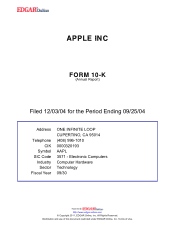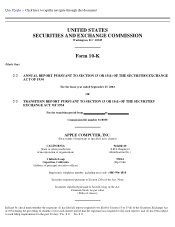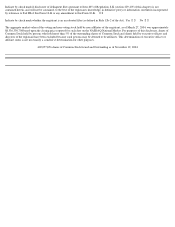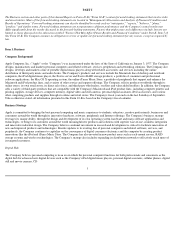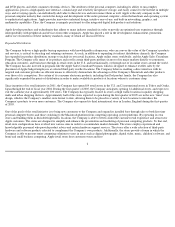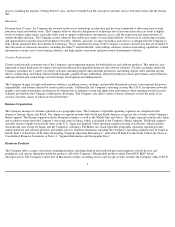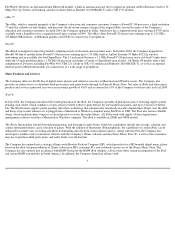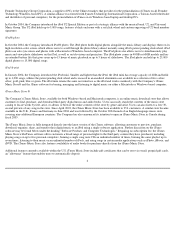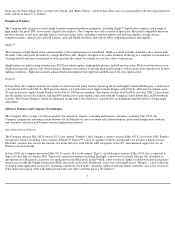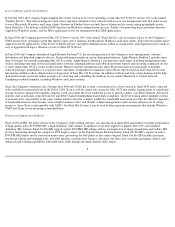Apple 2004 Annual Report Download - page 5
Download and view the complete annual report
Please find page 5 of the 2004 Apple annual report below. You can navigate through the pages in the report by either clicking on the pages listed below, or by using the keyword search tool below to find specific information within the annual report.
and DVD players, and other consumer electronic devices. The attributes of the personal computer, including its ability to run complex
applications, possess a high quality user interface, contain large and relatively inexpensive storage, and easily connect to the Internet in multiple
ways and at varying speeds, can individually add value to these devices and interconnect them as well. Apple is the only company in the
personal computer industry that controls the design and development of the entire personal computer—from the hardware and operating system
to sophisticated applications. Apple provides innovative industrial design, intuitive ease-of-use, and built-in networking, graphics, and
multimedia capabilities. Thus, the Company is uniquely positioned to offer integrated digital hub products and solutions.
Apple develops products and technologies that adhere to many industry standards in order to provide an optimized user experience through
interoperability with peripherals and devices from other companies. Apple has played a role in the development, enhancement, promotion,
and/or use of numerous of these industry standards, many of which are discussed below.
Expanded Distribution
The Company believes a high quality buying experience with knowledgeable salespersons, who can convey the value of the Company's products
and services, is critical to attracting and retaining customers. As such, in addition to expanding its indirect distribution channels, the Company
has expanded its product distribution strategy to include its own retail locations, Apple online stores worldwide, and the Apple Sales Consultant
Program. The Company sells many of its products and resells certain third-party products in most of its major markets directly to consumers,
education customers, and businesses through its retail stores in the U.S. and internationally, or through one of its online stores around the world.
The Company has also invested in programs like the Apple Sales Consultant Program, which is designed to enhance reseller sales by the
placement of Apple badged employees at selected third-party reseller locations. The Company believes enabling a direct interface with its
targeted end customer provides an efficient means to effectively demonstrate the advantages of the Company's Macintosh and other products
over those of its competitors. For certain of its consumer electronic products, including the iPod product family, the Company has also
significantly expanded the points of distribution in order to make available its products at locations where its customers shop.
Since inception of its retail initiative in 2001, the Company has opened 84 retail stores in the U.S. and 2 international stores in Tokyo and Osaka,
Japan through the end of fiscal year 2004. During the first quarter of 2005, the Company anticipates opening 14 additional stores, and expects to
exit the calendar year at approximately 100 stores. The Company has typically located its stores at high traffic locations in quality shopping
malls and urban shopping districts. Approximately half of the stores expected to open during the first quarter of 2005 are in the new "mini" store
design, which is the Company's smallest store format to date, allowing them to be placed in a variety of new locations to introduce the
Company's products to even more customers. The Company also opened its third international store in London, England during the first quarter
of 2005.
One of the goals of the retail initiative is to bring new customers to the Company and expand its installed base through sales to both first time
personal computer buyers and those switching to the Macintosh platform from competing operating system platforms. By operating its own
stores and building them in desirable high traffic locations, the Company is able to better control the customer retail experience and attract new
Apple customers. The stores are designed to simplify and enhance the presentation and marketing of personal computing products. To that end,
retail store configurations have evolved into various sizes in order to accommodate market demands. The stores employ experienced and
knowledgeable personnel who provide product advice and certain hardware support services. The stores offer a wide selection of third-party
hardware and software products selected to complement the Company's own products. Additionally, the stores provide a forum in which the
Company is able to present entire computing solutions to users in areas such as digital photography, digital video, music, children's software, and
home and small business computing. Apple retail stores host customer events and free
2

